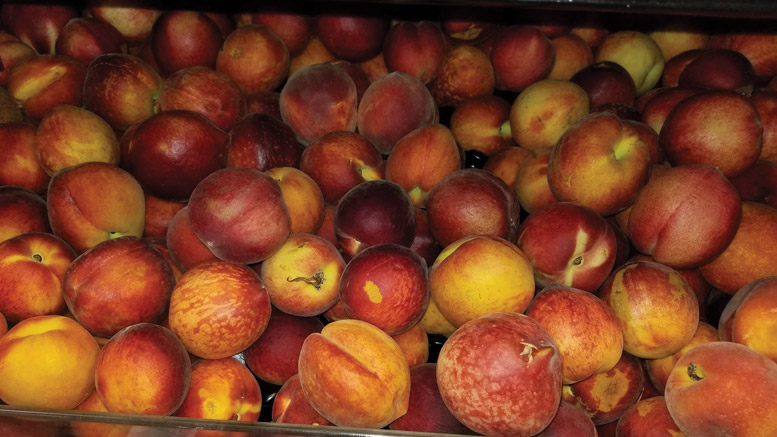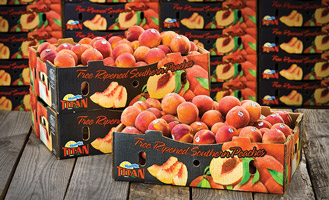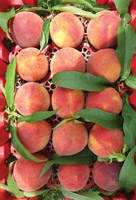SOUTHEAST PEACHES
March 1, 2019 | 10 min to read


Originally printed in the March 2019 issue of Produce Business.
Taste, logistics advantages help bring profits to retailers.
Flavor and accessibility are what differentiate peaches grown in the Southeast from other U.S. growing regions. From spring through the end of summer, growers in the Southeast are harvesting and shipping peaches. When the Southeast season begins, peaches become of high importance to retailers who move high volumes of fruit.
Throughout the Southern region — from Florida and Alabama through Georgia and South Carolina to West Virginia — growers produce a tasty piece of fruit that is highly desired by retail buyers. Because of their geographic location, Southeast growers can quickly ship peaches to supermarkets servicing a large East Coast population.
At Abingdon, VA-based K-VA-T Food Stores, Inc., which operates 131 stores in Virginia, Tennessee, Georgia and Kentucky, Southeast peaches account for 40 percent of the chain’s stone fruit volume in June, July and August. “Southeast peaches are a very important part of our stone fruit business,” says Keith Cox, produce category manager. “When you compare Southern peaches to California peaches, for us, 90 percent of our peach volume is Southern peaches. It really gives you a good idea of how important it is to have a Southern peach during those three months.”
Peach production begins in Florida in mid- to late March and shipments run through mid-May, when harvesting in Georgia usually begins. South Carolina, the leading East Coast producer of peaches, generally begins in mid- to late May.
“During that four-month period, from May through August, a time people know is synonymous with good peaches, you, as a retailer, really want to be known as a peach destination,” says Will McGehee, a partner with Genuine Georgia Group, based in Fort Valley, GA. “A Southern peach has an amazing amount of sugar. We promote Georgia but feel like we’re in a larger community in the Southeast. We want to make sure our customers have a good supply of Southeast peaches.”
TASTY FRUIT FOR WINTER BLUES
The Southeast fruit brings a taste of spring and summer to winter-weary Northeast shoppers. “When customers see these peaches coming in, they get excited, as it’s a prelude to our Jersey peaches and the first signs of summer,” says Sal Selletto, produce manager at the Super Foodtown of Sea Girt, NJ, a part of the Middletown, NJ-based Food Circus/Foodtown. “By that time, shoppers are kind of sick of the winter fruits and want to transition to the summer fruit. We put them up front, on center stage.”
Southeast peaches have been growing in reputation because of improving taste, according to Lake City, SC-based W. Lee Flowers & Co., Inc., a wholesale grocery provider and an operator of a chain of 65 IGA stores from North Carolina to Georgia. Last year, peaches jumped to the chain’s top three categories, joining the ranks of bananas and strawberries, says Mychael Thomas, director of produce. “Peaches are important because they’re local for us in the South,” he says. “We are proud to move as many as we have in the past. We try to push our local product as soon as it comes in season. That gives our customers and guests the taste they want. Being closer to home, peaches generate sales for us.”
Southeast peaches are known for their flavor. “A fresh, sweet Georgia peach is the most flavorful peach you can eat,” says Julie McPeake, chief communications officer for the Georgia Department of Agriculture (GDA). “That’s no accident. A lot of things have perfectly come together to give our peaches their one-of-a-kind legendary flavor. Our hot summer nights and high humidity allow our peaches to produce sugar all day and night. Most other growing regions cool down at night, and the peaches take a break from producing sugar. This cooling down at night is known to enhance a peach’s red color, but it stops crucial sugar development.”
Greencastle, PA-based Keystone Fruit Marketing sells peaches from Alabama, Georgia, South Carolina, Virginia, West Virginia, Pennsylvania and New Jersey. “The entire East Coast grows high-quality, high-color and great-tasting peaches,” says Mike Blume, director of sales and marketing. “What has changed over the years, other than the quality getting better and being more consistent, is the Southern region has expanded to the East Coast. New Jersey always had a great reputation for peaches, but now areas like Virginia, West Virginia and Pennsylvania are getting recognized as having excellent peaches, too.”
Florida’s peaches help generate spring interest in domestic peaches, says Mindy Lee, Fresh from Florida communications and media manager for the Florida Department of Agriculture and Consumer Services (FDACS). “Florida growers aren’t looking to supplant other markets,” she says. “They want to complement the peach category by filling the gap between South American and traditional North American markets with consistent volume.”
AN EATING EXPERIENCE
Southeast peaches possess eating characteristics retailers desire, says Benjie Richter, partner with Charlotte, NC-based Richter and Co., Inc., which markets for growers in South Carolina, Alabama and West Virginia. “Our fruit does eat better than the Western fruit, due to our climate,” he says. “Our fruit has more juice. It has a different sugar-acid ratio, which gives us a real peach flavor.” Giving shoppers choice, many retailers like to merchandise East Coast and West Coast fruit, says Richter. “We welcome that because our fruit competes very well,” he says. “The retailers like the fact our fruit is different.” Sometimes, retailers may merchandise Southern peaches for considerably lower prices than California fruit, says Richter.
The South’s growing and harvesting practices help produce quality peaches, says Bob Von Rohr, director of marketing for Glassboro, NJ-based Sunny Valley International, Inc., which markets South Carolina and New Jersey peaches. “For the most part, with the Southern peach, knowing they stay on the tree longer than possibly other areas, shoppers get more of a ready-to-eat peach from the South than from other areas,” he says.
A big advantage of Southeastern fruit is logistics. “We have an extreme advantage in freight costs to sell to Eastern markets,” says Matt Cornwell, sales account manager for Titan Farms, which grows and ships from Ridge Spring, SC. New regulations have increased trucking rates. “South Carolina’s location makes it ideal to service all major markets,” he says. “Fruit can be delivered to major markets in the Northeast, Midwest and the South in only a day or two, providing buyers and customers with fruit that came off the tree only a few days before it hits the shelves. By utilizing Southern fruit, buyers can save an average of $2 to $4 per case of fruit in freight costs versus the West Coast.”
Full trucks or LTLs can be coordinated for next day deliveries to most locations in the East and Midwest.
“Transportation, although difficult at times, is a huge advantage for selling and buying Southern and Eastern peaches,” says Keystone Fruit Marketing’s Blume. “The Southeast and Mid-Atlantic regions offer many customers on the East Coast and Midwest next-day delivery, and for others, second-day delivery. There are excellent growers in Georgia, South Carolina, Alabama, Virginia, West Virginia, Pennsylvania and New Jersey. To be able to pick, cool, pack, ship, and deliver all within a few days is ideal for buyers and, most importantly, consumers.”
SOUTH CAROLINA
 The Palmetto State is the largest producer of peaches on the East Coast, and the second overall U.S. producer. The state markets its peaches’ flavor.
The Palmetto State is the largest producer of peaches on the East Coast, and the second overall U.S. producer. The state markets its peaches’ flavor.
“Our slogan is we are the tastier peach state,” says Katie Pfeiffer, director of merchandising for the South Carolina Department of Agriculture (SCDA). “We have a sweeter and more acidic peach. We have a longer season than others in the Southeast, from May to August, maybe into September sometimes when we have a good year. We have a lot of varieties, which produce the flavor.”
Thanks to improved varieties, South Carolina growers begin harvesting a week to 10 days earlier than they did in the past, with shipments beginning May 5-10, depending on weather. “We can go longer into September than our competition,” says Matt Forrest, co-owner of Dixie Belle Peaches, which grows and ships from Ridge Spring, SC. “We can set up programs that can carry retailers from the beginning to the end.”
South Carolina’s slightly acidic soils, hot days and humid nights enable growers to produce peaches ripened on the tree and ship longer past summer, explains Matt Cornwell, sales account manager of Titan Farms, Ridge Spring, SC. “Producers send peaches to market starting in May and harvest all the way into September, a longer season than other states,” he says. “Varieties grown in South Carolina are known for their perfect balance of sweetness and acidity. Growers in South Carolina combine generations of growing expertise with state-of-the-art packing facilities to put a ‘tastier peach’ in the box.”
Shipping peaches long distances can be problematic. “The advantage of Southeast peaches is that we can get them to market usually within a day,” says Greg Reighard, a professor emeritus and visiting professor of horticulture at Clemson University in SC. “How quickly we can get them to the market is a very important factor in the quality. Because the fruit is not in cold storage for very long or at all, that’s what differentiates Eastern and Southeast fruit. You need heat and temperature to produce quality peaches. We have that in the Southeast.”
South Carolina is known for its large-sized peaches. “We always grow a big peach,” says Kyle Tisdale, an SCDA marketing specialist. “South Carolina has has a good reputation for harvesting big, juicy sweet peaches.”
The state enjoys a strong peach reputation. “We always say we ripen ours on the tree,” says Joe Watson, co-owner of Jerrold A. Watson & Sons, based in Monetta, SC. “We don’t have to pick them earlier and don’t have to take them to storage conditions to ripen. They’re cooled and shipped. Anywhere and everywhere you go, if people mention peaches, they always talk about South Carolina. Having high-quality, high-sugar peaches is what consumers want and what we strive to give to them.”
Peaches with fewer food miles appeal to retailers, says Benjie Richter, partner with Richter and Co., Inc., Charlotte, NC. Southeast shippers are closer to most East Coast and Midwestern retailers, he says. “We can be to the Eastern corridor cities of Boston, Baltimore and Washington, DC, and the Midwestern cities of Chicago, Cleveland and Detroit within 24 to 48 hours off the tree,” says Richter. “In most cases, our fruit is usually packed that day or the next day. You can’t get any fresher than that, which retailers realize. They like the freshness and the fact our fruit doesn’t have the food miles you have from California.”
Proximity to large-population areas also helps move South Carolina’s peaches. “Our state’s central U.S. East Coast location coupled with an integrated transportation system of 41,000 miles of highways, means South Carolina is within a two-day drive of 75 percent of the U.S. population,” says Pfeiffer. “Today’s consumer is increasingly more aware of the distance their food travels. Sourcing more Certified South Carolina produce close to that population base makes great business sense.”
Because peaches were profitable when South Carolina growers began growing them, they were grown all over the state. Because of freezes, production has since focused on areas such as the Ridge, the sand hills and the Piedmont regions, says Watson. “Over the years, where peaches are now grown, there are microclimates amenable to growing peaches,” he says. “Other places went out of production because they had frost and couldn’t grow peaches. The people who are in it now are the ones who have been in it for years and grow only high-quality peaches.”
GEORGIA


“We are able to get our peaches to just about every metropolitan area within a day. That’s a big deal when you’re dealing with a peach, which isn’t like other commodities which don’t mind being stored, like apples, bananas or citrus.”
The logistical benefits help retailers. “Georgia enjoys important production and marketing advantages, primarily its proximity to Eastern markets and favorable prices because of early harvests and high-quality fruit production,” says Julie McPeake, chief communications officer with the Georgia Department of Agriculture. To give Georgia peaches more time on the tree and less time until it gets to retail customers, most of Georgia’s fruit is picked, packed and shipped in the same day, she says. “We gladly take on this logistical challenge because we are simply obsessed with flavor,” says McPeake. “It’s all we think about.”
The first Georgia peaches were shipped to New York between 1858 and 1860. They were transported by wagon to Augusta, GA, then by shallow-draft boat to Savannah, GA, before being loaded on a steamship. That’s when Georgia earned its “Peach State” designation during the three decades following the Civil War, notes McPeake.
The Fort Valley plateau, where 90 percent of Georgia’s peaches are grown, historically experiences fewer freezes, more consistent rainfall and consistent year-over-year temperatures, says McPeake.
FLORIDA


Many of Florida’s citrus growers have turned to peaches to diversify their acreage, says Mindy Lee, Fresh from Florida communications and media manager for the Florida Department of Agriculture and Consumer Services. “Seasonally stretching from Central Florida in March through South Carolina in August, peaches from Florida offer a nearly seamless category available between South and North America,” she says.
Florida peaches’ smaller size and juicy, flavorful flesh helps distinguish the Sunshine State’s fruit from other regions, says Lee.
Ripened flavor is a key part of the appeal of Florida peaches. “Part of the whole Florida deal is that we come in ahead of all the other states,” says Alise Edison, vice president and owner of Deer Park Peaches, based in Deer Park, FL, on Florida’s East Coast. “Ours are tree-ripened. They don’t get sweeter. Once they come off the tree, they may get softer. We try to go for absolute tree-ripened sweetness. We’re not trying to ship them all over the place.”
Florida peaches are gaining more of a foothold in the marketplace, notes Finch. “Demand has been good,” he says. “Consumers are looking for them in the supermarkets now and are waiting for the season to begin. We are beginning to build a loyal following for Florida peaches.” Florida Classic is going into its 10th season of growing and shipping peaches.
With 22 million residents, the Sunshine State remains a key market for Southeast peaches. “Florida, the state, obviously is local,” says Finch. As many people identify local as food miles from where product is harvested, anywhere in the Southeast can almost identify with local Florida peaches into the Deep South,” he says. “Many retail groups support local grown programs. It is important in the state of Florida that Florida peaches are well-represented in the marketplace.”
9 of 23 article in Produce Business March 2019

